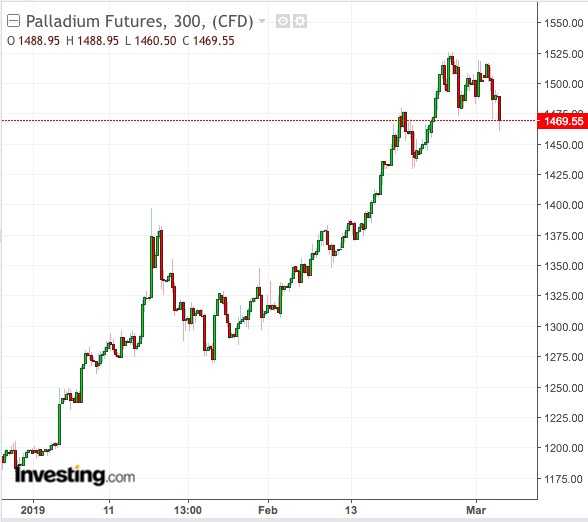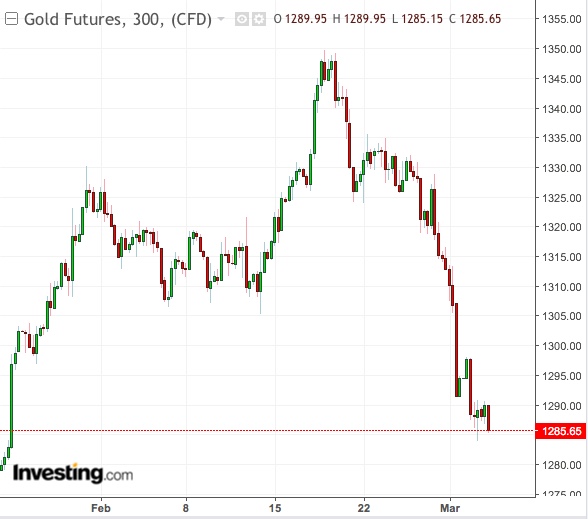Forget yellow, and think white instead: palladium, which has smashed records of $1,500 an ounce, may get to $2,000, according to industry analysts, giving an opportunity for investors fleeing gold to get into an alternative super-hot precious metal.
The price of palladium, a silvery-white metal that serves as a catalyst and emissions purifier for gasoline engines, has eclipsed that of gold since December—the yellow metal that has been man’s favorite ornament, store of value and safe haven in times of trouble.
In early Tuesday trade, spot palladium hovered at $1,530 an ounce against spot gold's $1,290.
Palladium Could Reach $800 Premium To Gold
The difference of under $250 an ounce could swell to $800 and beyond if palladium reaches the $2,000 target forecast by analysts, and gold gets stuck where it is or slips further below $1,200.

Some say palladium’s 25% gain this year—matched only by crude oil—is a bubble that could pop soon due to exaggerated demand versus supply shortages from mine strikes and other production outages. They also argue that gold could recapture the $1,300 perch it lost this week should the U.S.-China trade war remain unresolved and fresh global tensions push investors back toward safe havens.
Despite such alternative views, an array of analysts are betting that the explosive rally in palladium will continue, citing runaway demand from automakers and a further squeeze in mine supplies.
Bank of America Ups Palladium Target By 22%
Metals strategists at Bank of America Merrill Lynch said they have raised their palladium forecasts by 22% to an average of $1,800 an ounce this year, with a peak target of $2,000.
Analysts at Investing.com are also bullish on spot palladium, recommending a “Strong Buy” in their daily technical outlook. But their highest target is only $1,608.90 per ounce.
BofAML isn’t the only source with lofty projections for palladium.
UBS Group's metals strategist Joni Teves also has $2,000 palladium in his sights, though he warned of a pullback should the market get to such levels, Bloomberg reported.
BofAML, in a note issued Monday, said its palladium forecast was “firmly supported by fundamentals on the physical market”.
It added:
“Traditional supply/demand and price charts usually can give an indication as to where commodity markets clear. To that point, price elasticities assure that oil quotations between $50 and $70 per barrel are justified in the coming years. Yet, palladium supply and demand are inelastic, so there is no price at which the market clears, with the deficits plugged by inventories.”
The BofAML note pointed out that for years this wasn’t an issue, but persistent inventory declines of late have increasingly raised apprehension over the availability of palladium.
More than four-fifths of the world’s palladium comes as byproduct from nickel mining in Russia and platinum mining in South Africa. That leaves its supply dependent on the success of extraction in those two metals.
Platinum, Rhodium Far From Being Credible Substitutes
While platinum, which is more widely available, has been cited as a substitute, more technological advances will be needed before it can deliver the kind of efficiency automakers get from palladium-based catalytic converters, said Johnson Matthey (LON:JMAT), which makes the devices. Platinum’s worth is more as a catalyst for diesel engines, a value eroded since the 2015 Volkswagen (DE:VOWG_p) emissions scandal hit Europe’s diesel car output.
Rhodium) is another possible replacement, but supply of the metal, which isn’t publicly traded, is scarcer than that of palladium.
In a platinum group metals (PGMs) outlook published last month, Johnson Matthey said:
“The deficit in the palladium market looks set to widen dramatically in 2019, with stricter emissions legislation forecast to stimulate double-digit rises in palladium demand from European and Chinese automakers.”
“Although recoveries from autocatalyst scrap should rise again, the rate of growth in secondary supplies is likely to be lower than in 2018, while primary shipments are expected to be flat.”
More Knocks From Trade Talks Likely For Gold
In gold’s case, supply’s not the problem but rather sentiment, as each upbeat remark about U.S.-China trade talks sends the yellow metal further into $1,200 territory. Technical analysts at Investing.com have a “Strong Sell” on spot gold in their daily outlook, forecasting a bottom as low of $1,266.84.

Gold got to seven-month highs of $1,300 on Jan. 20 after a long struggle, but slipped from that key threshold last week. Gold bugs were stunned by that, as central banks in recent weeks had been aggressively buying bullion on worsening worries over Brexit and other global troubles.
While gold has alternated with the dollar as a hedge to the U.S.-China trade war, the greenback has proven to be a more effective safe-haven play for this, gaining traction at the expense of the yellow metal since last week, after U.S. Trade Representative Robert Lighthizer said that Washington and Beijing were still far apart on a trade deal.
Ironically, the dollar rose again on Monday, along with U.S. Treasury yields, dealing another knock to gold, after a Chinese official contradicted Lighthizer, saying the two countries have made substantial progress in their talks.
